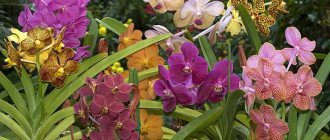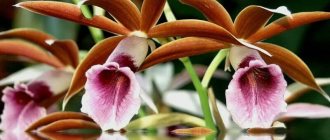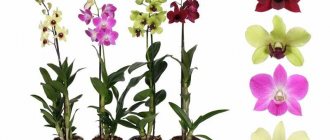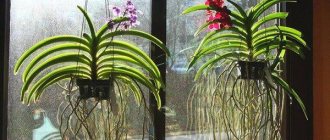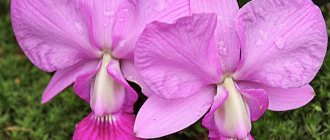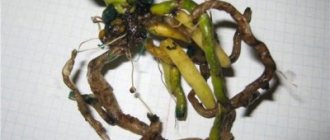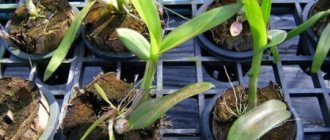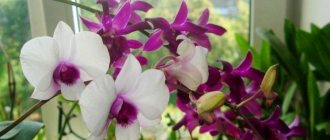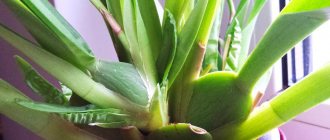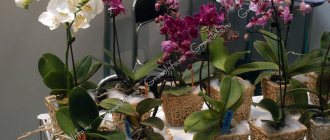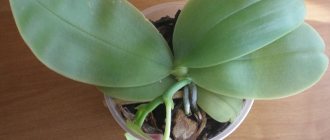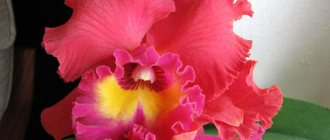Terrariums are chic glass containers that house tiny plant worlds. More and more orchid lovers are moving from growing plants on windowsills to more enclosed spaces where they can have much better control over conditions such as humidity. One of the benefits of creating a terrarium is that you can create a self-contained miniature environment quite easily. It is important to understand what will and will not work for orchids in such an environment. The main thing is to reproduce the growing conditions for the orchids that we place in the chamber. Thus, high humidity, good air circulation and adequate lighting are required.
Preparing the terrarium
- For mini terrariums, large vases or medical jars are often used. But if you are using an old aquarium, you will have to do a little work. If it was a fresh water tank, you will just need to thoroughly clean it with mild dish soap and rinse thoroughly. If it was a salt water tank, you will need to repeat this a few times and perhaps let it sit with clean water for a few days between cleanings. The reason is that any residual salt will definitely cause you grief in the future. Therefore, it is better to deal with this right away.
Placing the terrarium
Choose a place where the terrarium will never be exposed to direct sunlight. Glass enhances the sun's rays, resulting in an oven rather than a terrarium. Leave at least 30cm between the tank and any window surface to mitigate temperature changes occurring outside.
If you have an area with only minimal direct sunlight, you may want to consider adding a white reflective background to compensate for the amount of light entering the tank.
It may be wise to place the thermometer in an empty tank for a couple of days before you place it in the intended location. This will prevent unpleasant surprises and eliminate the need to move the terrarium after installation.
Dry aquarium-orchidarium
The majority of orchidarium aquariums have walls made of silicate glass, the thickness of which increases by 2 cm in a row: from 4 to 6, from 10 to 12, but there are also designs with wall thicknesses of 15 and 19 mm. Large orchidariums also have a large pond: they are called multi-sectional or multi-story products of modern production.
There is a pond at the bottom, plants in the middle part, and blooming orchids at the top.
Companion plants
It is always more effective if you use at least a few companion plants that are not orchids to make the environment more varied and interesting to the eye. Choose plants that stay very short or grow very slowly. All candidates must be able to withstand high humidity at all times. Good choices include low ferns, ivy, peperomia, short nephtis, fibrous-rooted begonias, rheo, selaginella, short crotons, and small dracaenas. You can find many of them with variegated or white, pink or red spots. These options can provide some color when the orchids aren't blooming, but keep them to a minimum or the setting may look too busy and less natural.
In addition to filler plants, you can also use companion plants that are commonly found with orchids, such as members of the bromeliad family. Tillandsia and Cryptanthus are excellent choices and will also bloom producing very exotic flowers. They can even be mounted higher up on poles to create a realistic jungle look.
Aquarium, terrarium and orchidarium
An aquarium, like aquarium furniture in a true classic style, has been popular and in demand for several centuries. There is a great demand for display aquariums and cabinets. If the interior of the house allows you to view the structure from all sides, then quite beautiful stands are made to order from solid wood or placed on a chest of drawers covered with a laminated surface that is not afraid of moisture. It is possible that there are niches in the house left by the builders for furniture sets: they are also adapted for structures with water.
Terrariums are fundamentally needed for red-eared turtles, swamp turtles, and their aquatic sisters - trionics. The house for the red-eared turtle is equipped with basic equipment, which includes lamps for lighting and heating the island, a water filter and other devices, and the latest models of such products are also offered with a designer coating on the back wall.
The orchidarium, or paludarium, where live orchids thrive, is not so common in Russia, but it can also be purchased if you make a reservation. Naturally, such an accessory will decorate any room, but not everyone can buy a ready-made orchidarium right away so that the design fits one hundred percent. It’s better to order it from the manufacturer, and besides, they can make it a combination for you: it will be decorated with driftwood, and the back wall will be covered with cork oak.
In addition to Phalaenopsis orchids, you can grow other plants for your home in such orchidariums. They thrive in warm microclimates and reproduce quite quickly.
Filling the terrarium
Rinse the pebbles in water to remove dust and debris. Place a layer of stones at the bottom. Add sphagnum moss. Leave the center lower as the orchid will nest there. Sphagnum moss is quite fluffy, try to put enough of it in so that the orchid has a strong layer in which to grow.
Leaving orchids in their original clear pot is the best way to ensure proper growth and the least amount of damage to your colorful and beautiful plants. Once the bottom stones are in place, place one or two orchids inside the terrarium. Using sphagnum moss to hide the pots will give the terrarium a finished, fantastic look. If the orchid has roots that were above the pot, carefully place them in the terrarium on top of the sphagnum moss.
How to do it yourself?
It’s not very often that you see ready-made compositions in specialized stores. And even the beautiful solutions you see lead to the desire to create something similar yourself.
Or the best. Especially after seeing copies from friends. Yes, and on the Internet. Especially if you have something to make them from at home. The following is step-by-step instructions for creating your own florarium.
Necessary items and materials
Various materials can be useful for making a florarium:
- Containers made of glass or thick transparent plastic. Various sizes and shapes: Aquariums;
- Decanters;
- Banks;
- Bottles and bottles;
- Glasses and glasses;
- Flasks;
- Vases. Etc.
Hanging florarium in a flask.
- Wooden and metal objects : slats, wire, corners;
- of different colors and configurations . Sea pebbles ;
- Expanded clay. For the drainage layer;
- Soil and sand corresponding to the selected type of orchid;
- Very often moss. Especially sphagnum moss ;
- Charcoal . You can use activated carbon tablets. To prevent the occurrence of fungal diseases;
- Figures and objects for decorative design of the composition;
- Available tools : gloves, tweezers, spatula, spoon or fork (maybe plastic), watering can;
- If you make the container yourself, you will need other tools. For cutting and gluing.
Advice! To create complex and voluminous containers, gardeners install thermometers, hygrometers, fans and additional lighting.
Primary requirements
When creating florariums, you expect that it will please you for a long time. Here are some rules (requirements) you need to take into account:
- Choose small plants. And still slowly growing;
- They must match the selected containers;
- Plant plants that are easy to care for. For which the soil, lighting, watering and temperature will be suitable. Just like orchids. Or similar ones.
To create a florarium, the smallest types of orchids are used.
Important! There are interesting situations. Plants were chosen according to taste. But plants need different soil. Create zones with different soils. If capacity allows.
What types of orchids are best?
Many gardeners successfully use various plants for florariums:
- Cacti;
- Various fittonias;
- Violets;
- Moss;
- Ferns;
- Salaginella;
- Cyclamens;
- Stone rose;
- Youthful;
- Single options look more modest. But passionate flower growers do not always agree with this.
Flower growers carefully use orchids for florariums. It’s more convenient to do everything with small plants:
- Phalaenopsis. More often its miniature varieties;
- Cattleya;
- Paphiopedilum. He is also Venus's slipper;
- Even Wanda.
Replant in spring. Better with unopened buds.
Important! When replanting a blooming orchid (especially if a gift is being prepared), it is especially important to do everything correctly.
Orchids occupy a special place among florarium plants. Here you can try to create suitable conditions for species that are quite demanding and capricious in terms of living conditions.
The orchid can be accompanied by variations of fittonia, fern and sphagnum moss.
Manufacturing technology
Your florarium can turn out differently:
- Select the required container . It must be clean, disinfected and degreased (alcohol). Steaming is also quite suitable. Handle it carefully. To prevent cracking: Ready-made jars (bottles, glasses, etc.) are suitable for this;
- If you want to create the container yourself: Select and cut out the required shape of the part. Made of glass or transparent plastic. Plastic is easier to work with. And safer;
- Using glue and sealant, you create a structure according to your design.
Creating a container for a florarium.
- Create drainage. Fill with expanded clay and pebbles. In a layer of 2-3 cm. Add small fractions of charcoal (activated carbon tablets);
- The thickness and composition of the soil depends on the type of orchid and the size of its roots;
- Plant orchids and other plants in the depressions . Compact the soil for other plants and water lightly. Add soil;
- Place moss and decorative items.
Caring for orchids in a terrarium
Orchids are found throughout the world and grow in a wide range of climates. However, most orchids you find in stores are more tropical in origin. That's why orchids love humidity and bright, indirect light. A bathroom or adjoining room is a great choice.
Avoid exposing orchids to freezing temperatures, as most cannot handle it.
A potting mix that drains well but also retains some moisture (such as sphagnum moss is a good base).
Florarium or Ward's box
Ward's box was invented in 1829 by physician and avid botanist Nathaniel Bagshaw Ward. Dr. Ward collected various plants and was interested in botany. But he encountered a problem: the plants did not tolerate London's polluted air.
Flowers in an open terrarium. Photo used as illustration. Source: Yandex.Images
One day he noticed ferns growing well in a closed glass case. Experiments began with planting in glass boxes, during which it was discovered that the plants in the florarium were growing healthy.
He then tested the transport of flowers on a ship and found that, even in very poor conditions, they survived. For this reason, Ward's boxes were used to transport new specimens and important crops around the world.
. Florariums were also used as fashionable living room decorations in Europe and the USA.
Since different Orchids require different environments, it will take some time and experimentation to find the optimal conditions.
Ward's box is great for Orchids. You can buy it in a specialized store, or make it yourself from an ordinary jar. The main thing is that the flower matches its size. Keep the container moist and away from direct sunlight as it easily overheats.
Watering and humidity
It is best to use rain or distilled water for orchids, since it is impossible to get rid of accumulated salts in the terrarium. It is enough to lightly spray with plain water every 4 days. This will depend on the location and ventilation. Humid air tends to sink, so little moisture escapes unless you have fans running.
Placing 2cm of water in the rocks creates a moist environment in which the orchids can live. Make sure that orchid roots are not placed in standing water, as they may rot.
If the terrarium appears dry, simply add water to increase the humidity in the self-contained environment. If the terrarium appears consistently damp along the walls, open it briefly to remove some of the moisture.
Note. Some people prefer to use soil at the bottom of the terrarium. Despite its beautiful appearance, it is easy to introduce disease into the terrarium if soil is used as a substrate.
Care without substrate
Types of orchids and their installation (planting)
In principle, epiphytic orchids can grow and develop safely without a substrate if they are provided with the proper microclimate .
Each type of epiphytic orchid has its own biological characteristics, formed at the genetic level, depending on its natural place of growth. Therefore, many orchid growers grow them :
- In banks;
- Glass balls;
- Aquariums;
- Showcases without using substrate.
Orchids are hung from the side walls, driftwood or large stones are installed. The main thing is to give stability . By creating a natural landscape (if the size of the container allows), you can successfully grow any epiphyte.
Caring for such plants includes:
- Maintaining high humidity;
- Consistent and correct application of supplemental nutrition.
The substrate, in its essence, only serves to stabilize the plant in the container. epiphyte orchid receives its nutrition (without being a parasite). Therefore, there is no particular difficulty in caring for it without soil.
Watering, fertilizing
Timely and correct watering, fertilizing and maintaining the microclimate in the aquarium will ensure :
- Full development;
- Height;
- And flowering.
You can feed the orchid without soil while immersed in water.
The need for watering depends on the temperature inside the aquarium-terrarium. The cooler it is, the less watering is required. Beginners should first of all pay attention to the change in color of the roots. As soon as the roots change color from light green to brown or shades thereof, the plant requires watering . With experience and observation of the condition of the orchids, the process is perfected until it becomes automatic.
Fertilizers are applied in two ways:
- By sheet;
- Or by immersion in water with the addition of necessary microelements.
IMPORTANT! Typically, the feeding procedure is carried out 2 times a month.
In large display aquariums, the watering process is carried out using the method of root irrigation . More advanced orchidists even irrigate using nozzles made for this purpose, aimed at the root system.
To avoid overdrying or overwatering, you need to strictly monitor humidity and ventilation (ventilation). sphagnum moss is placed on the bottom (driftwood, stone, drainage) .
Timely ventilation or turning on a fan will prevent the formation of stagnation of moist air and the appearance of fungal diseases.
Transfer
You can ignore the need to repot your orchids as they will attach to other surfaces in the terrarium and will be quite happy if left alone.
Pests and possible problems
If you live outside the normal range of orchids, you probably won't have many problems with insects. Remove any visible pests immediately and, if necessary, use the lowest concentration of pesticides possible.
Orchid leaves can become sunburned if exposed to direct sunlight. It starts as dark spots on the leaves that eventually become dry and golden (and look like fall leaves).
Most orchid species are relatively forgiving, with leaves, stems and roots containing a lot of water. A forgotten orchid will last a long time before it dies. Don't rush to discard your orchid if it seems unhealthy, take the best care of it and it may recover.
